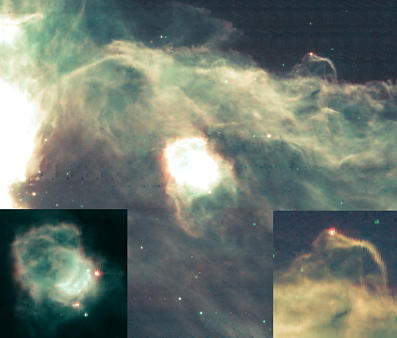
ISOCAM image at 7 and 15 microns
ESA/ISO/ISOCAM and L. Nordh (Stockholm Observatory) et al.
(Image x2)
[Hi-Res: JPEG with optical observation]
The Horsehead Nebula in Orion protrudes from a large dark cloud into a region brightly lit by glowing hydrogen gas. The scene changes dramatically when examined by the European Space Agency's Infrared Space Observatory, ISO. Some light regions become dark, while the dark cloud glows with filaments shining by the infrared light emitted by interstellar dust. Only the top of the horse's head remains.
The bright nebula in the centre of the scene, called NGC 2023, is larger in the infrared image. Much of the infrared brightness right across the scene, including the horse's head, comes from emissions by carbon compounds (polycyclic aromatic hydrocarbons or PAH).
Bright dots seen in the nebula NGC 2023 and at the top of the Horsehead itself, include young, newly formed stars detected by their infrared emissions. These young stars are plainest in the insets, where different intensity scales favour the relatively cool young (red) stars.
The infrared images are composed from observations by ISO's camera ISOCAM at wavelengths of 7 and 15 microns. Comparisons of the intensities of point-like objects at different infrared wavelengths provide a powerful means of identifying young stars hidden in the dense, dusty clouds in which they are born. The observations of the Horsehead Nebula and its surroundings form part of a programme of research by a team of astronomers from Sweden, France, Italy, the UK and the European Space Agency, who are making a census of young stars in selected regions.
The Horsehead region is part of a gigantic star-making cloud that includes the Orion Nebula. It is in a sector of the sky that the ISO space observatory would have been unable to visit if the spacecraft's operating life had not been extended by the excellent performance of its liquid-helium cooling system.
These observations have been discussed in the ISO/ESA Press Release;
"New water and remote galaxies complete ISO's observations".